Synology BeeDrive Review – Bit Different?
Synology has been one of the biggest names in the world of storage for both home and business users for well over 20 years, and although they have been predominantly associated with network-attached storage, they have occasionally dabbled in alternative storage mediums. In just the last 5 to 6 years, we have seen them explore the world of routers, hard drives, SSDs, and surveillance cameras, and now they have rolled out a new external SSD backup device- the Synology BeeDrive. Designed for and targeted at no-nonsense, beginner-level local backups, the BeeDrive stands in stark contrast to the majority of Synology solutions in their portfolio. They’re attempting to find a middle ground between the convenient and easy backup processes found in the likes of Google Drive and Dropbox, alongside the ease of Apple Airdrop file transfers, while avoiding the complexity of network-attached storage. It’s a big undertaking and one that more serious storage veterans may scorn as overly simplistic at best, or limiting at worst. But what about the target audience of comparatively inexperienced storage users? How will they find the Synology BeeDrive? Let’s review this comparatively new backup system and help you decide if it deserves your data.
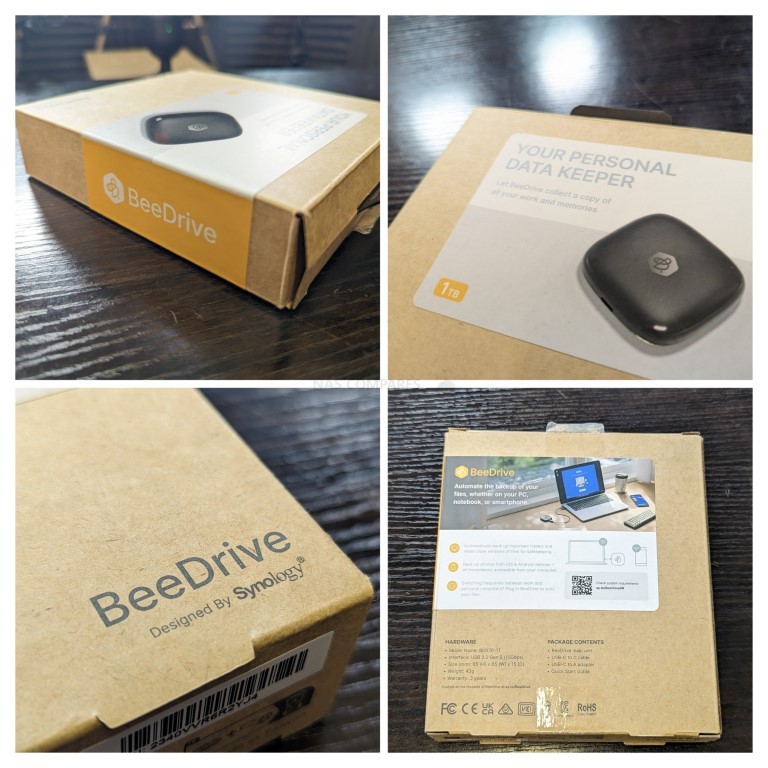
Synology BeeDrive Review – Quick Conclusion
The Synology BeeDrive is a well-made product that aligns with Synology’s style. Its software is excellent, the build quality is top-notch, and its operation is incredibly user-friendly. Despite its robust software capabilities, including support of multiple clients and versions, customization of file synchronization and backups, and the Synology BeeDrop functionality, the BeeDrive might appear under-featured when compared to Synology’s own NAS servers. However, the need for a connected PC client for backup and synchronization applications, although crucial for the BeeDrop feature, might make long-term operations of the drive less smooth for some. Despite the clear differentiation in target audiences for these products, Synology’s reputation in the NAS world makes comparison inevitable, even for entry-level users. The BeeDrive might seem simplistic at launch, but perhaps long-term integration with Synology’s ecosystem will alter this perception. If you’re looking for simple, uncomplicated local backups between your client hardware, the BeeDrive could be a suitable, low-impact alternative to a NAS. For everyone else, a Synology Value Series box with a couple of drives might be a more evolved storage solution.
| Where to Buy a Product | |||
|
|
    
|

|
VISIT RETAILER ➤ |
 |
    
|

|
VISIT RETAILER ➤ |
 |
    
|

|
VISIT RETAILER ➤ |
 |
    
|

|
VISIT RETAILER ➤ |
 DEAL WATCH – Is It On Offer Right Now? DEAL WATCH – Is It On Offer Right Now?These Offers are Checked Daily
|
Synology BeeDrive Review – Retail Packaging
The packaging for the Synology BeeDrive is definitely aimed more at off-the-shelf purchases than exclusively e-retail. Arriving in a fantastic compact box, the BeeDrive is a modest and small-footprint storage device that weighs less and is smaller than the majority of external hard drives we have reviewed so far.

The box contains a fairly standard cardboard framework and the drive includes the expected accessories that you would find with most external drives. There’s the Synology BeeDrive itself, available at launch in one-terabyte and two-terabyte capacities, an external USB C to USB C cable, a USB C to A adapter, and a first-time setup manual. All software that is included with the Synology BeeDrive, which is arguably the main selling point of this drive, can be found online and is downloadable via multiple 3D barcodes and Synology’s own website.
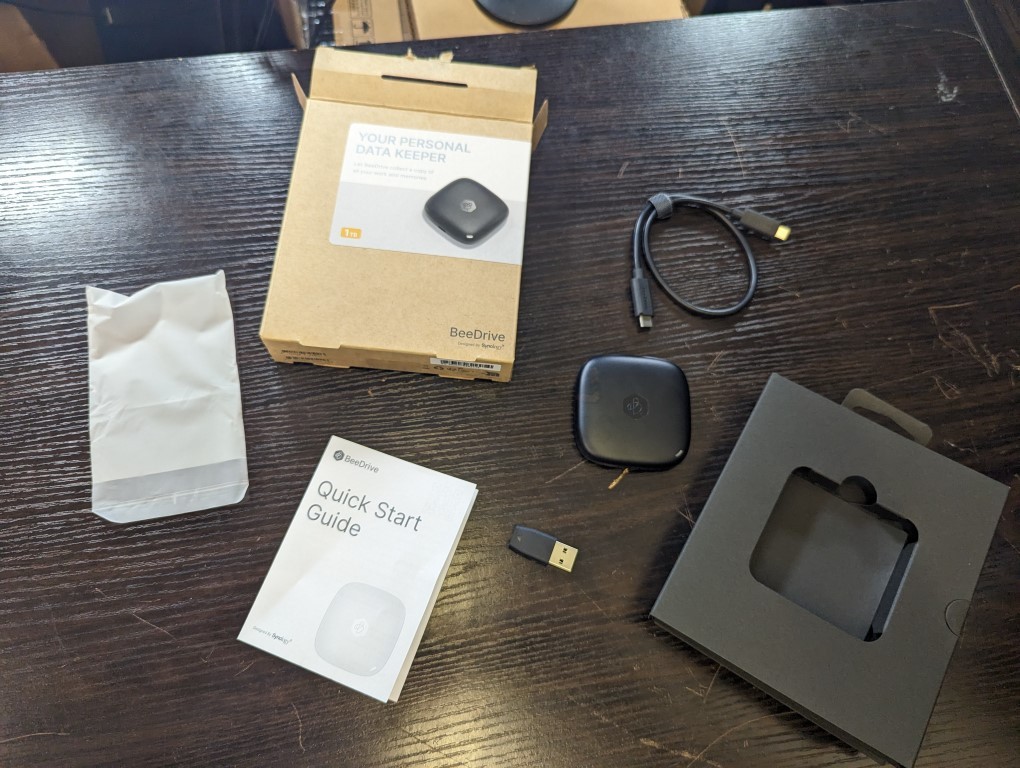
As you would expect, the quality of all of the components included is pretty high and although they aren’t really anything special, they are all branded appropriately much like any Synology product. Aside from the USB cable being a little short, I can’t really fault the accessories. The USB type A adapter clicks in neatly and firmly too.

Given the price tag that the Synology BeeDrive arrives at, with the 1TB at approximately $139 and the 2TB at $199, I would certainly expect a high production quality, and this does not disappoint. However, it also does not blow the mind.

Synology BeeDrive Review – Design
The first thing that you notice about the Synology BeeDrive external SSD is that it is fantastically small and light. Synology has continued to leverage the improved storage capacity per cell and the result is that this drive is clearly using a very small form M.2 NVMe SSD drive inside. At the time of writing, I was unable to identify the SSD that is being used inside the Synology BeeDrive, but I will dismantle the drive later and update this review and the YouTube video accordingly once identified. Indeed, identifying the SSD inside the Synology BeeDrive was challenging, even utilizing tools such as Crystal Disk Mark.

The only physical connection on the Synology BeeDrive is a USB type C connector at the base of the device which serves as both the data transfer and power supply for this drive. It is a USB 3.2 Gen 2 interface which means that it can achieve speeds of 1,000 megabytes per second, thanks to the internal NVMe inside. Likely, this SSD could achieve higher speeds outside of this external enclosure, but that would require utilization of more modern USB Gen2x2 connectivity, USB 4, or Thunderbolt interface, which would increase the base price and limit the number of users able to take advantage of these higher performing interfaces.

The design of the Synology BeeDrive is quite slick and tremendously understated. But then again, the market is not exactly short of modest and slickly designed external SSD drives in 2023. So what exactly sets the Synology BeeDrive apart from other USB drives on the market, which are perhaps a little bit more affordable?

What Makes the Synology BeeDrive Any Different from a Normal External SSD?
When it was first revealed that Synology was rolling out external SSDs into their portfolio, the big question for many was what exactly they were bringing to this type of storage that didn’t already exist from numerous external USB SSDs in the market from the likes of Seagate, WD, SanDisk, and Sabrent. Right now, you can pick up a 1TB external hard drive for about $40, a 5 gigabit external SSD for about $80, and a 10 gigabit external USB SSD for about $99. With the Synology 1TB BeeDrive SSD arriving at a suggested $130, what exactly is Synology doing differently from what these other drives offer?
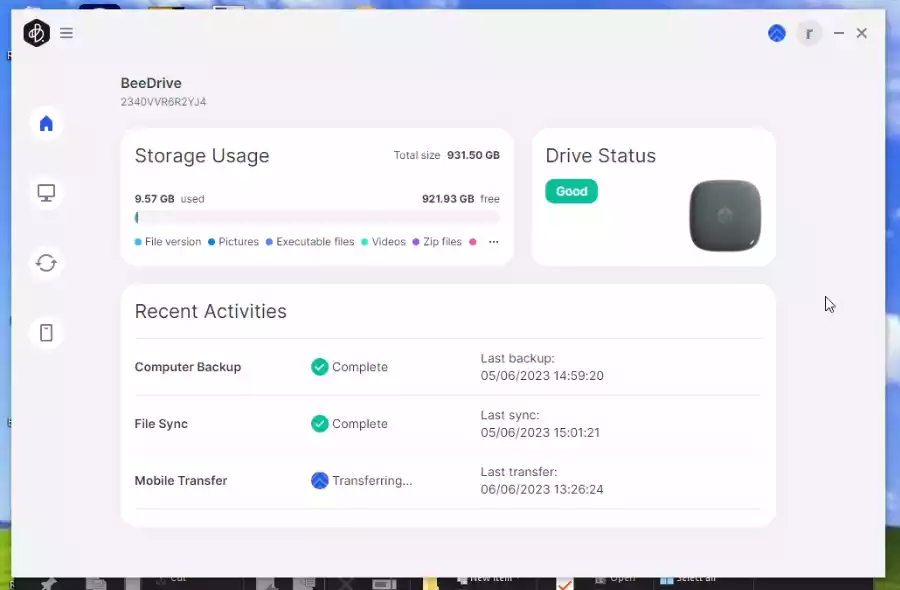
Much like the bulk of Synology products, the real appeal of the Synology BeeDrive lies in the software. Despite Synology NAS hard drives having comparatively lower hardware specifications in the market, it’s the DSM software that sets them apart from others and what carries the premium price tag for the majority of Synology products. The same is very much true of the Synology BeeDrive, thanks to the inclusion of Synology-designed backup, sync, and live drop functionality being presented in an incredibly user-friendly and near-seamlessly integrated fashion.
Upon connecting the Synology BeeDrive to your local PC and installing the software, an array of backup, synchronization, and live file drop services become available across multiple devices. It enables synchronization and backup of files from up to five different devices to the BeeDrive. The software provides several customization options to fine-tune your backups. These include maintaining up to five versions of a given backup file, allowing reversion to older versions if needed, and file format and size policies to ensure non-essential bulky files are excluded while crucial files and folders are backed up. The software also supports one or two-way synchronization, allowing you to decide whether files in multiple locations are mirrored or if one device is designated as the primary creation point and the other as the backup.
“BeeDrop” is another impressive feature that allows quick transfer of files from your connected iOS or Android mobile device to your desktop. This function, reminiscent of Apple AirDrop, facilitates seamless and wireless transfer between all your devices. While other third-party applications or chat or synchronization platforms offer similar services, these generally require you to utilize third-party storage and cloud providers, raising questions about the security of your data during and after the file exchange.
The BeeDrive software for mobile services is available on both Android and iOS. However, desktop client support is currently limited to Windows systems, with plans for Mac OS support expected later. While the BeeDrive provides a range of impressive features, one significant limitation is that it needs to be connected via USB to a PC client device when in operation. Unlike Wi-Fi supported external drives that run on battery power, such as the WD wireless passport drive from 2018, the Synology BeeDrive can only operate when connected to a computer. The computer then communicates with connected clients via its network adapter/LAN.
Despite this, there are some advantages to the BeeDrive system. For example, for those who frequently work off-site (such as at photo shoots, video production on location, creating reports at a client’s office, or while traveling), the BeeDrive provides an automated means to back up data upon return to your office. By simply connecting the BeeDrive to your main machine, all backups and synchronization will occur automatically. Furthermore, the BeeDrive supports up to five PC client devices. Users who frequently move between different Windows machines may find the BeeDrive useful not only for carrying data between these different client machines but also for live synchronization upon connection with each of them. This creates a portable master drive that constantly syncs with multiple systems in a nearly seamless manner. Cross-platform support already exists with the Synology BeeDrive having both iOS and Android support. This is further enhanced with support for converting HEIC to JPEG inside the BeeDrive and its software, allowing seamless image transfer and viewing between these different client profiles.

However, it must be acknowledged that the BeeDrive is best suited to those who prefer hardware to handle all the data management with minimal input by the end user. While utilizing a network attached storage device does have a steeper learning curve and requires your NAS system to either be on an intelligent schedule or on 24/7, NAS systems still offer significantly more capability than this type of entry-level backup solution. The BeeDrive should not be seen as a replacement for owning your own private NAS server. The Synology BeeDrive has only recently been launched, and Synology will likely improve its integration into their ecosystem. Therefore, it might seem premature to evaluate this product in its initial state, when it’s very likely that we’ll see this device’s capabilities expand, particularly in terms of support for the Mac platform and integration with the Synology NAS DSM platform. If the Synology BeeDrive could be connected to a Synology system with the proprietary Synology B application, it could offer a less resource-intensive way to backup and synchronize files and folders on your client devices than existing solutions like Synology Drive or Hyper Backup.
![]()
It might also prove beneficial to allow connected client devices to have sync and backup privileges with the Synology BeeDrive, which would be managed and safeguarded by the technology NAS, thus ensuring these client devices do not have access to the larger long-term storage array. Although the BeeDrive is a well-made device with a promising software package, it may not appeal to established Synology NAS users and appears to be targeting more entry-level, hassle-free storage users.
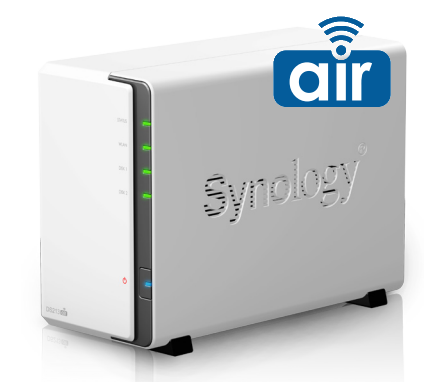
It’s worth noting that the BeeDrive is not Synology’s first venture into wireless storage backups. About a decade ago, they introduced the Synology DS213 Air, a traditional 2x NAS device with DSM and RJ45 connectivity, and a built-in wireless adapter. Though Synology never followed up on this product, one could argue that the BeeDrive is aimed at the same user base, albeit its requirement for a connected PC client might dilute this argument.
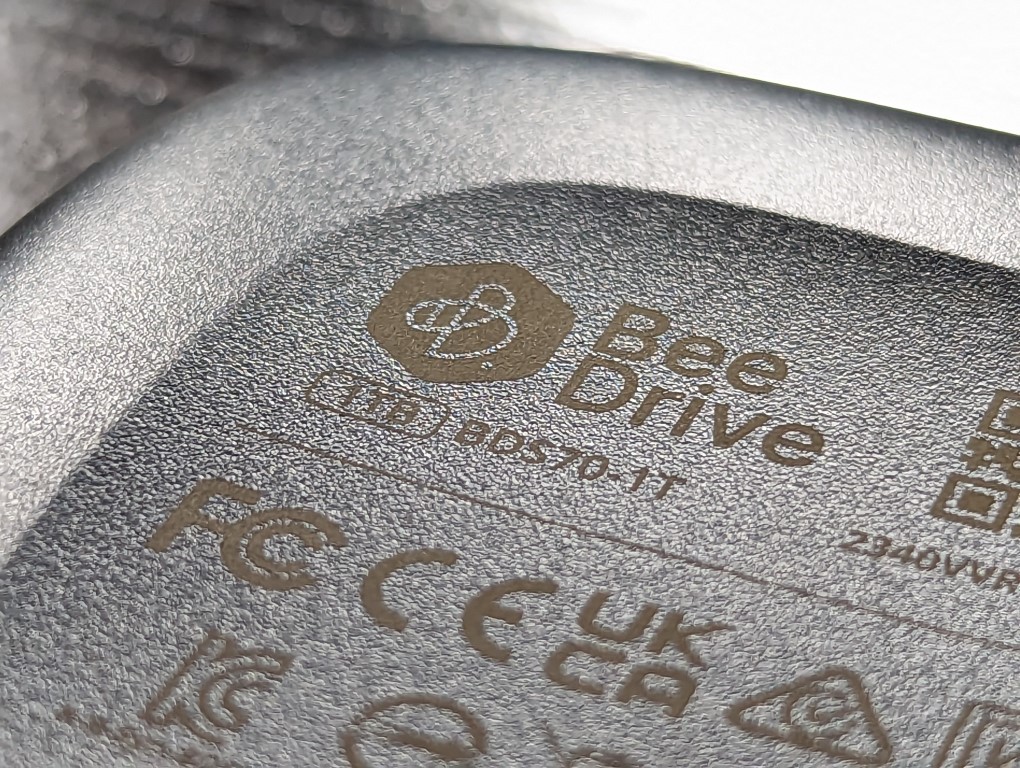
Synology BeeDrive Review – Review Conclusion
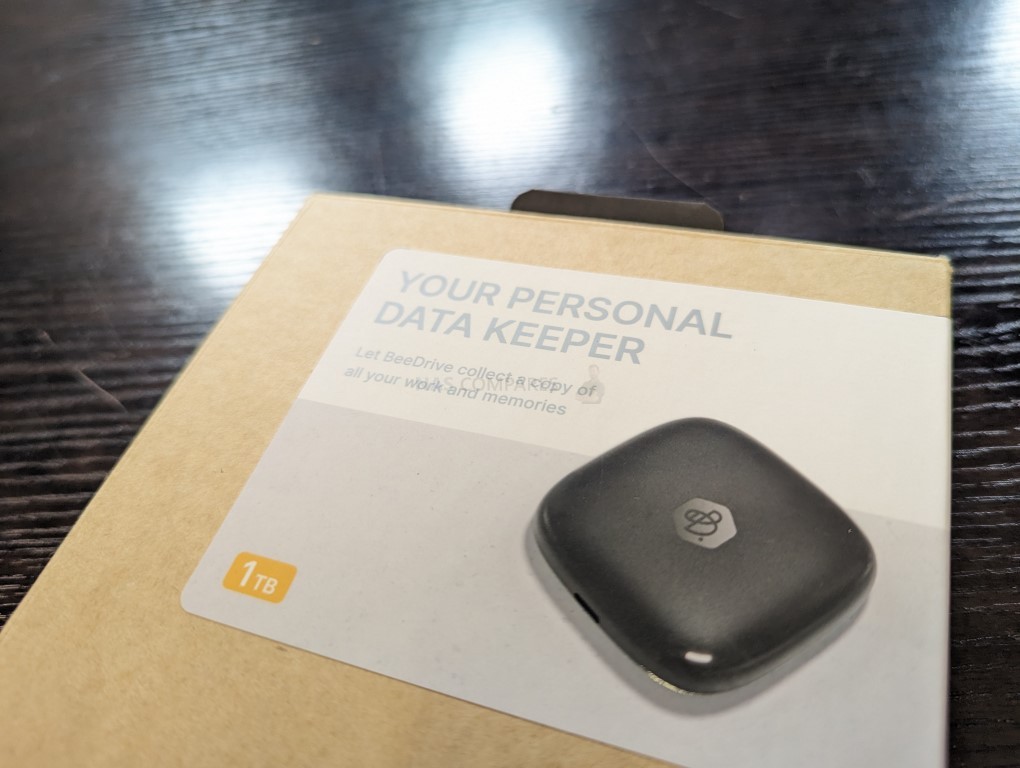
The Synology BeeDrive is a well-made product that aligns with Synology’s style. Its software is excellent, the build quality is top-notch, and its operation is incredibly user-friendly. Despite its robust software capabilities, including support of multiple clients and versions, customization of file synchronization and backups, and the Synology BeeDrop functionality, the BeeDrive might appear under-featured when compared to Synology’s own NAS servers. However, the need for a connected PC client for backup and synchronization applications, although crucial for the BeeDrop feature, might make long-term operations of the drive less smooth for some. Despite the clear differentiation in target audiences for these products, Synology’s reputation in the NAS world makes comparison inevitable, even for entry-level users. The BeeDrive might seem simplistic at launch, but perhaps long-term integration with Synology’s ecosystem will alter this perception. If you’re looking for simple, uncomplicated local backups between your client hardware, the BeeDrive could be a suitable, low-impact alternative to a NAS. For everyone else, a Synology Value Series box with a couple of drives might be a more evolved storage solution.
| Synology BeeDrive PROS | Synology BeeDrive CONS |
|
|
Need More Help Choosing the right NAS?
Choosing the right data storage solution for your needs can be very intimidating and it’s never too late to ask for help. With options ranging from NAS to DAS, Thunderbolt to SAS and connecting everything up so you can access all your lovely data at the touch of a button can be a lot simpler than you think. If you want some tips, guidance or help with everything from compatibility to suitability of a solution for you, why not drop me a message below and I will get back to you as soon as possible with what you should go for, its suitability and the best place to get it. This service is designed without profit in mind and in order to help you with your data storage needs, so I will try to answer your questions as soon as possible.
📧 SUBSCRIBE TO OUR NEWSLETTER 🔔
🔒 Join Inner Circle
Get an alert every time something gets added to this specific article!
This description contains links to Amazon. These links will take you to some of the products mentioned in today's content. As an Amazon Associate, I earn from qualifying purchases. Visit the NASCompares Deal Finder to find the best place to buy this device in your region, based on Service, Support and Reputation - Just Search for your NAS Drive in the Box Below
Need Advice on Data Storage from an Expert?
Finally, for free advice about your setup, just leave a message in the comments below here at NASCompares.com and we will get back to you. Need Help?
Where possible (and where appropriate) please provide as much information about your requirements, as then I can arrange the best answer and solution to your needs. Do not worry about your e-mail address being required, it will NOT be used in a mailing list and will NOT be used in any way other than to respond to your enquiry.
Need Help?
Where possible (and where appropriate) please provide as much information about your requirements, as then I can arrange the best answer and solution to your needs. Do not worry about your e-mail address being required, it will NOT be used in a mailing list and will NOT be used in any way other than to respond to your enquiry.

|
 |
Jonsbo N6 DIY NAS Case Review
The Best Bits (and Worst Bits) of NAS of 2025!
Minisforum MS-02 Ultra Review
Minisforum N5 NAS, 6 Months Later - Better, Worse, the Same?
Beelink ME Pro NAS Revealed
Best SOLID STORAGE NAS of 2025
Access content via Patreon or KO-FI
Discover more from NAS Compares
Subscribe to get the latest posts sent to your email.


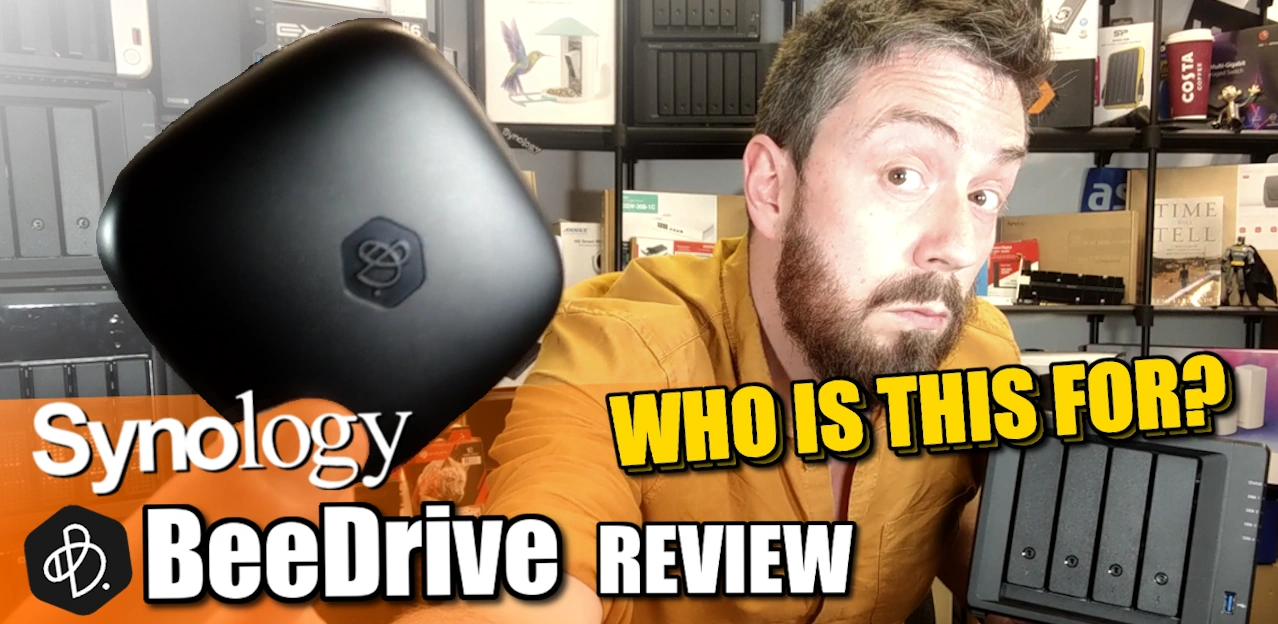

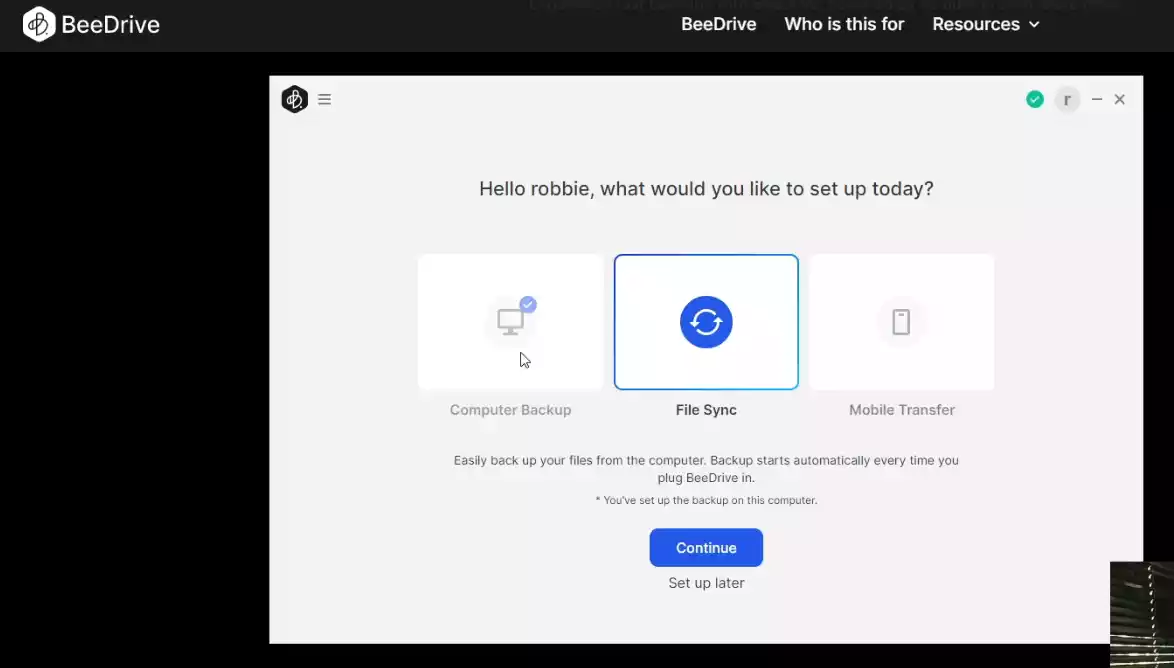
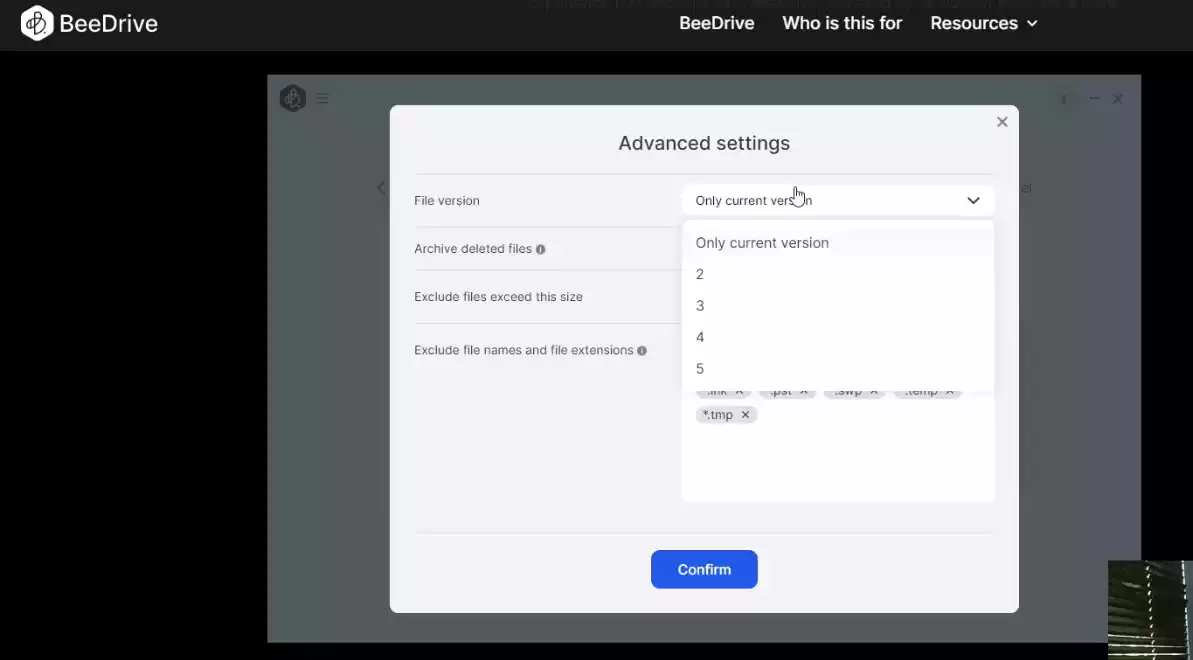

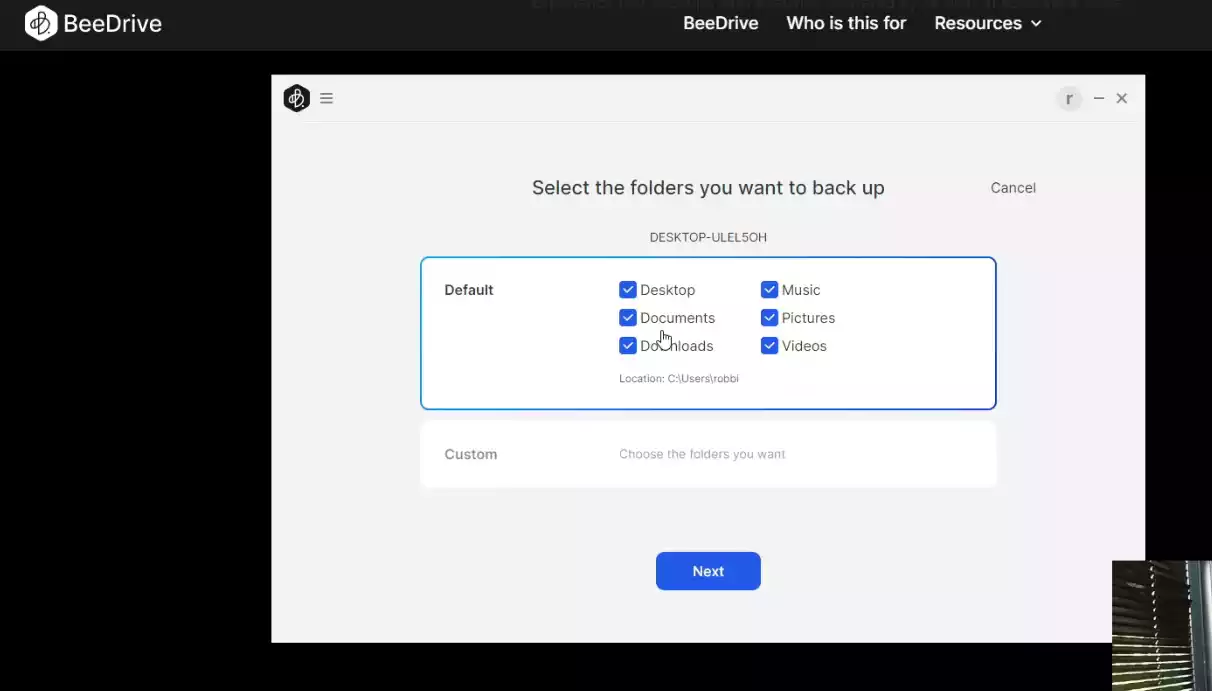
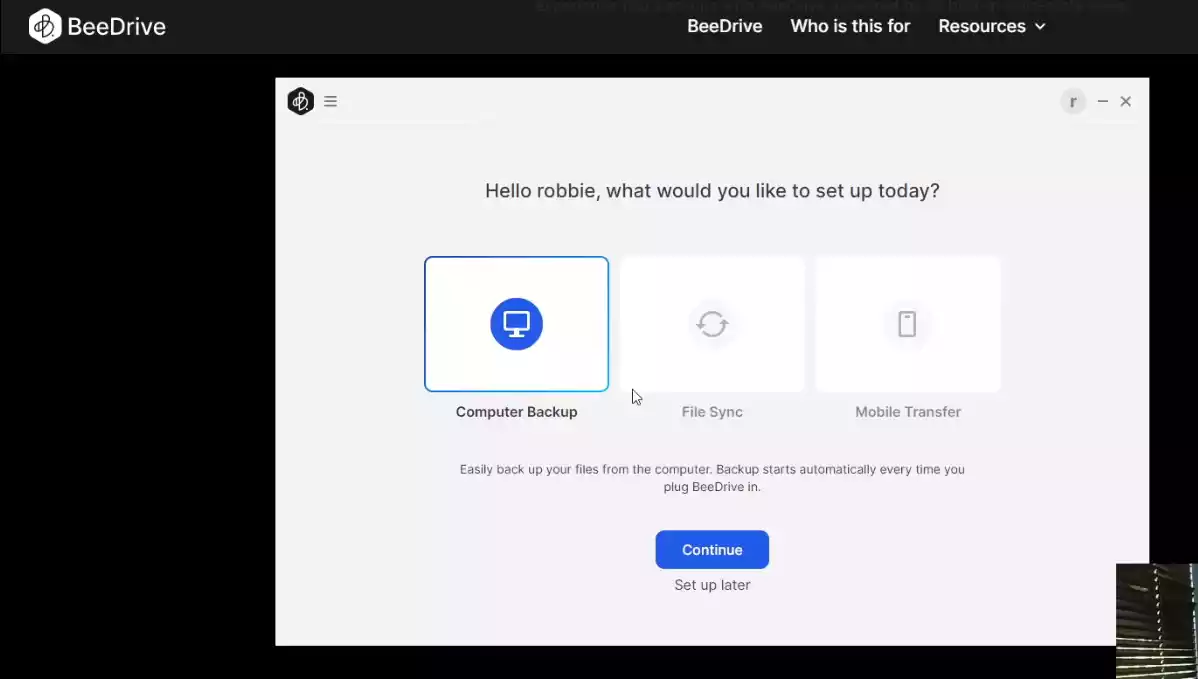

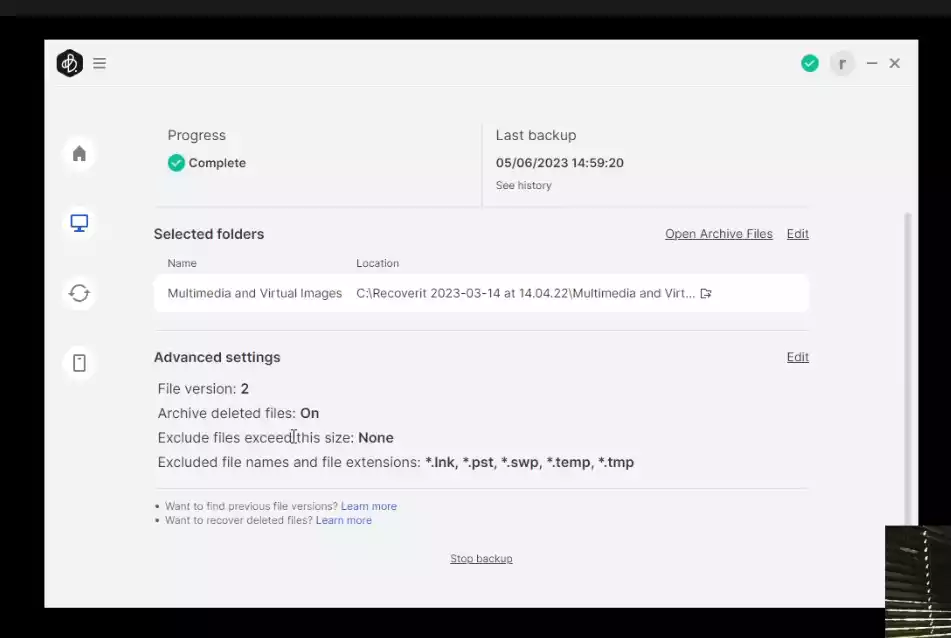
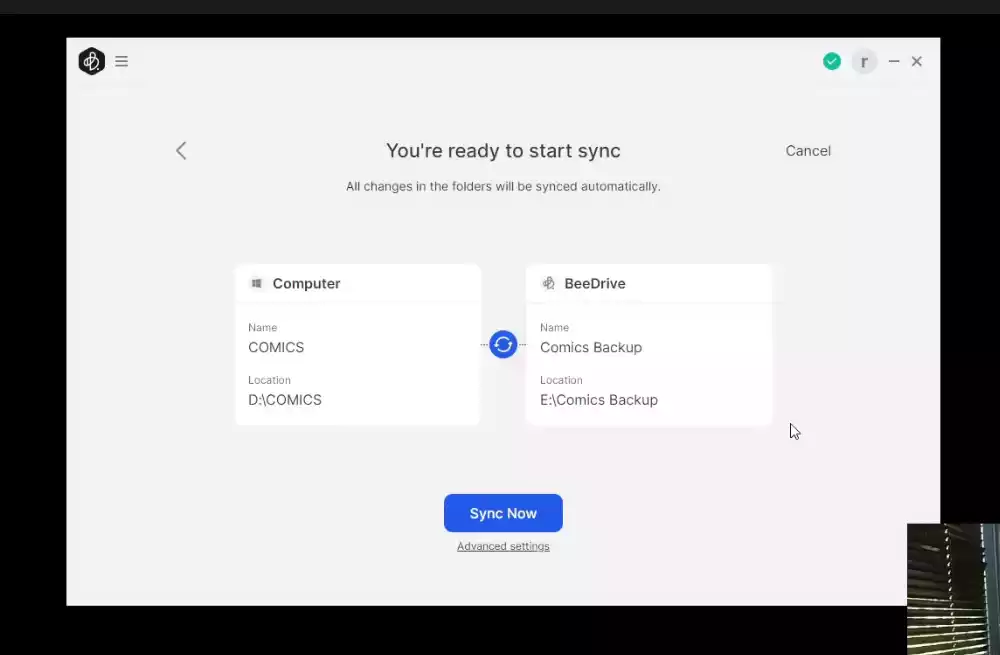
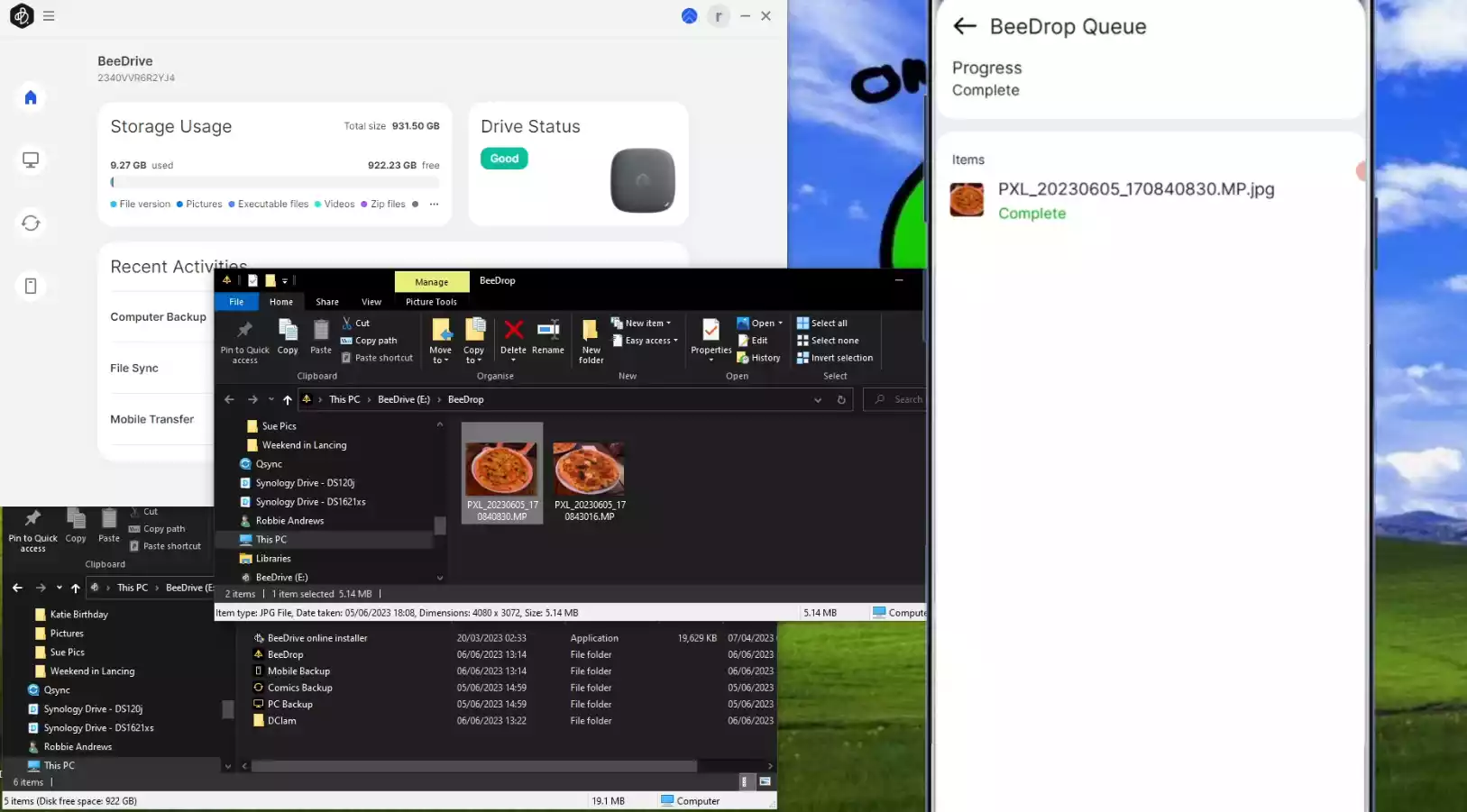
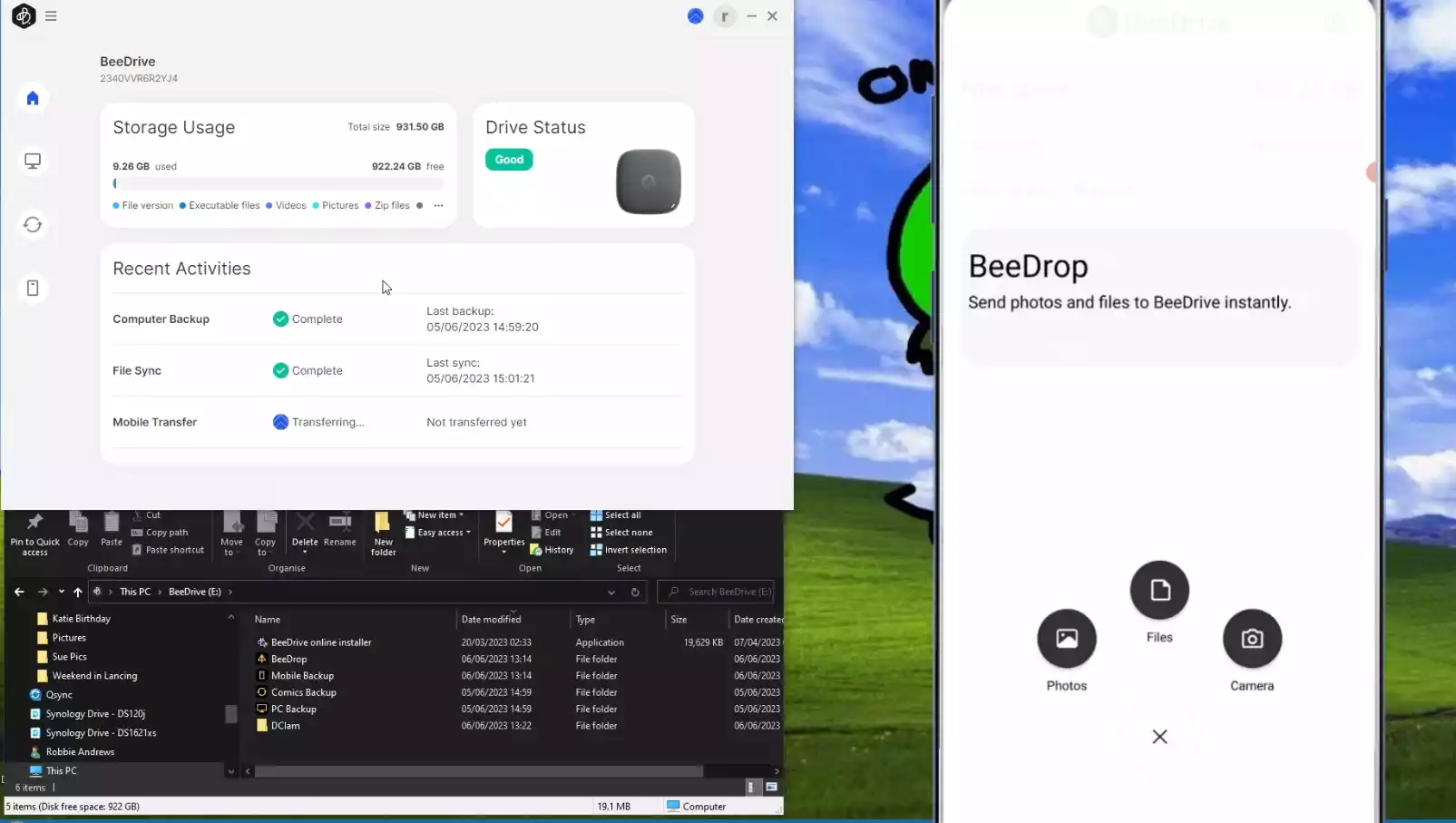
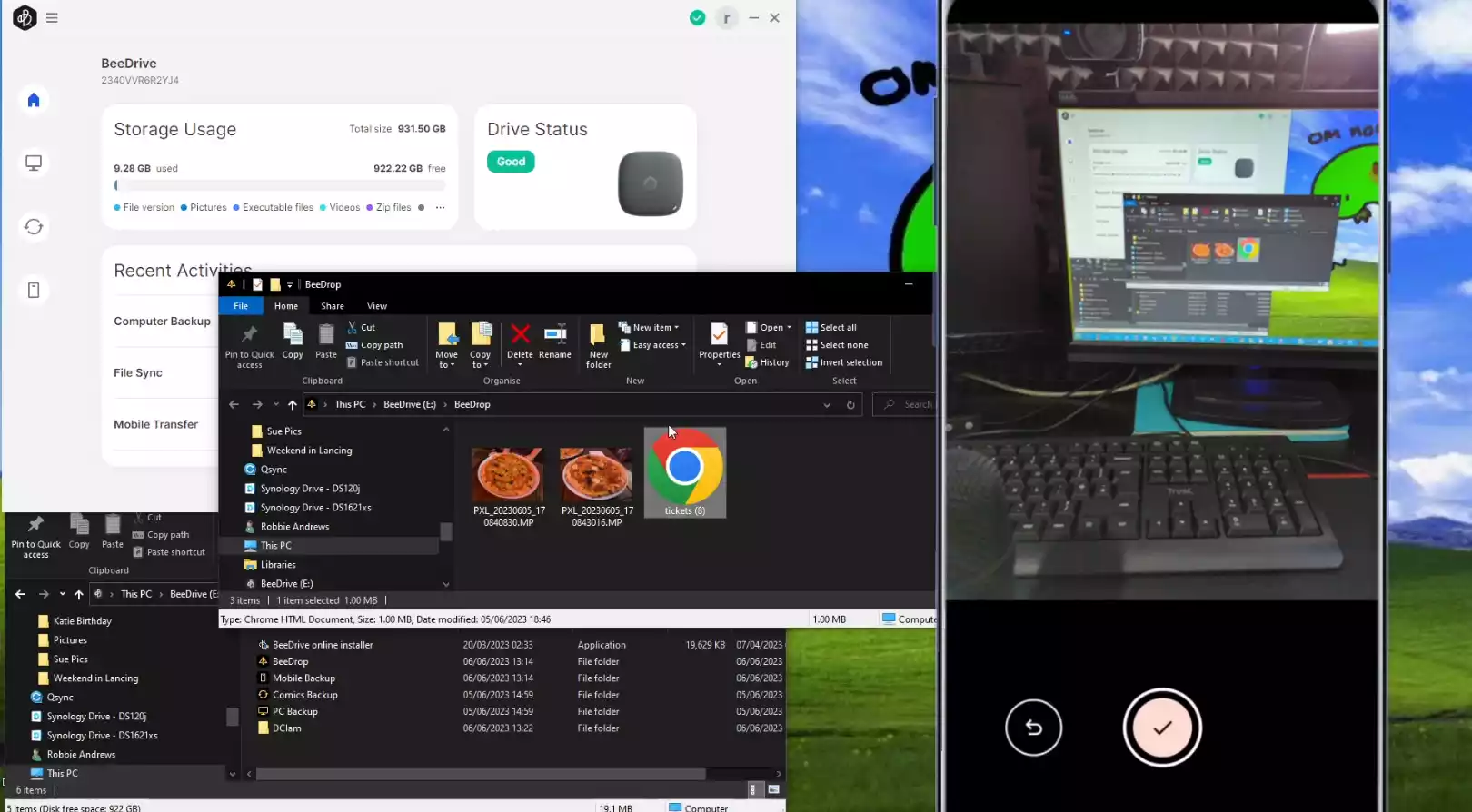
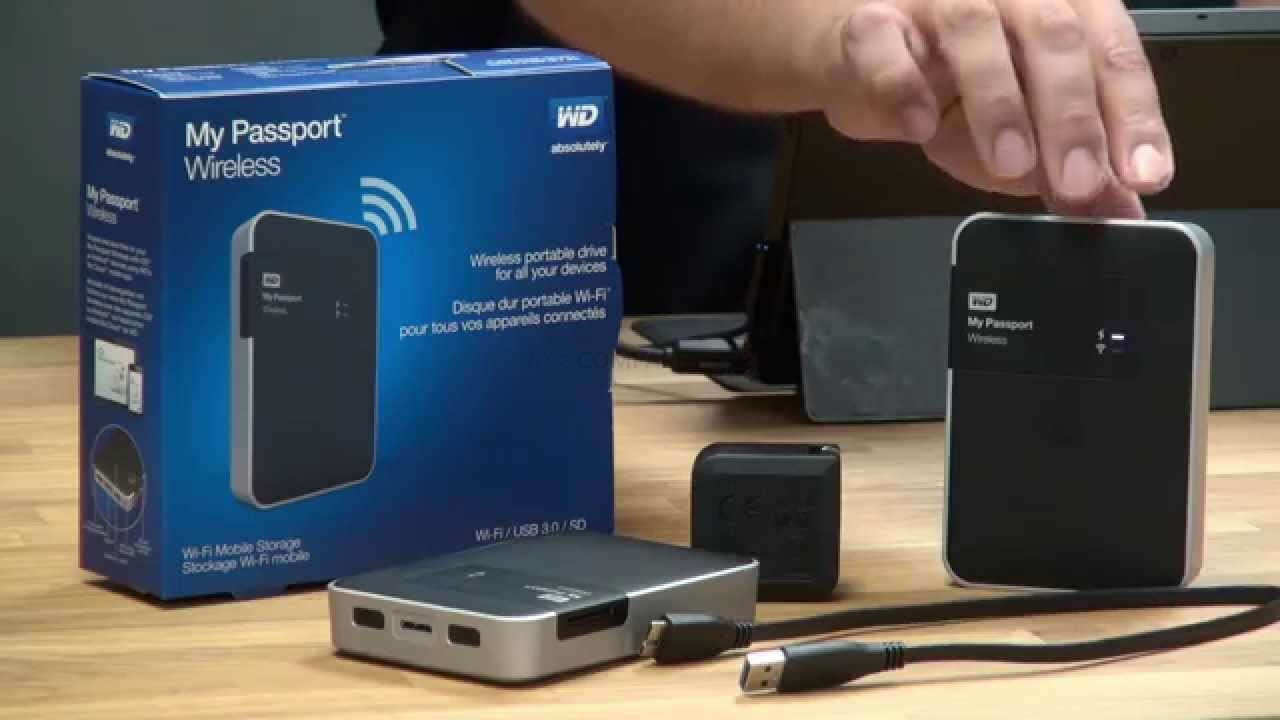




Too much talk at the start is quite annoying
REPLY ON YOUTUBE
They wasted the opportunity to create an independent system for it and call it BeeDSM ????
REPLY ON YOUTUBE
Hi. I´m a wildlife photographer and during my trips I take tons of stills and footage. At the end of day I download camera cards content to my external portable SSD device and/or laptop. As soon I arrive home I then transfer them to my Synology DS923+ . Most of the times it works well but recently I´m having issues with the DS923+ not recognizing my external SSD drives thus I have a transfer problem. I found your YT video and I wonder on the possibility to replace my 3rd party SSD drives with this beedrive. I would love to know your opinion. Thank you so much. Jose
REPLY ON YOUTUBE
Why everywhere on bee app it says photos …why not photos and videos…does it also backup videos as well?
REPLY ON YOUTUBE
Could this be attached to home router, or which synolgy is great for that
REPLY ON YOUTUBE
Does this device allow you to make a backup and synchronize with the external drives that our Mac has or only the internal drive?
Thank you.
REPLY ON YOUTUBE
Always enjoy how comprehensive your videos are. Thank you for the informative video.
REPLY ON YOUTUBE
i won’t put much value to wifi connectivity, it would be cool, but is it really that useful? Connecting directly to the sdd via wifi just have 1 pro, you don’t need the cable. For that you have a price though, you’ve to disconnect your device from internet which make you’re device mostly useless for the time you’re transferring stuff to your drive (it’s either wifi through router or wifi through the ssd, isn’t it? unless you have some fancy device that can connect through different wifi lans, not something that many not techy people have/do) and also it will obviously be a slower connection than the cable one. + you’ll have to take care of the battery.
REPLY ON YOUTUBE
Is it correct it can backup up to 5 desktop (via 5 backup tasks? Eg me n my family member) or only 1 desktop max? Wished have larger capacity too
REPLY ON YOUTUBE
I can see this fit to backup sensitive files of laptop (HR with payroll info) that cannot be back up to NAS or cloud n risk being seen by IT admin . Yes similar solutions exist but to pair both the hardware ssd n software together I think I not yet seen done. Looking forward to it.
REPLY ON YOUTUBE
BeeDrive 1.1 is out now! With this new update and full *QuickConnect* support, you can now back up photos and videos from anywhere, even when your phone and BeeDrive are on different networks.
REPLY ON YOUTUBE
Idk if I missed it but can you back up different phones on different folders to the drive?
REPLY ON YOUTUBE
You have a lot of synology at your back,how do you use that.Haha.Subscriber here.
REPLY ON YOUTUBE
what we are paying or buying here is the software? since the hardware I see there is not difference from the Scandisk 1TB for example
REPLY ON YOUTUBE
Do you get synology photo software w it ?
REPLY ON YOUTUBE
I don’t have wi-fi, so I can’t use it in the handy dandy way, but I can still physically connect it to my laptop and use it in the same way as I do with my SanDisk 1 TB SSD. Is that correct?
Thank you for this video, you are very thorough.
(I purposely don’t have wifi because Microsoft does auto Windows updates which will make my important software incompatible)
REPLY ON YOUTUBE
But cant i use this bee drive to make an update over usb on my synology nas?
REPLY ON YOUTUBE
Hello. Great video and thank you. I was going to purchase a BeeDrive for my daughter. She needs an alternative to iCloud. What do you think? I would like your opinion please.?
REPLY ON YOUTUBE
This is similar to the now long-gone ClickFree backup drive (two iterations of which I own) that was available from the likes of the QVC shopping channel a few years ago. And therein lies the appeal. It’s a simple plug and go backup device that gets the job done with minimal user knowledge. The only drawback, it seems to me, is that the user has to remember to use it!
REPLY ON YOUTUBE
Ideal solution for some of my clients who buy external drives and then wonder how to use them to backup their favourite stuff. The BeeDrive seems simple enough, and while it isn’t for me (I use Synology NAS solutions) it is ideal for those guys.
REPLY ON YOUTUBE
Thank you for the interesting and instructive video. You showed the SanDisk SSD’s, I own two of those(1TB & 2TB) with which I constantly experience problems. Ever since I acquired then. Issues such as not detected(or very slow to be recognised by the system ), corrupt data, empty drives, etc.. occur on a regular basis. I believe other people have experienced such frustration resuming in lack of trust for important storage. I’m using this on Max computers. Are you aware of such problems and possible remedies ? Thank you in advance for your reply. regards. Michael
REPLY ON YOUTUBE
Great video – thank you.
REPLY ON YOUTUBE
This could be interesting for my parents. Do the PC and mobile backup work automatically after setting everything up? So, I would do the initial setup and then they just plug it into the computer and computer/mobile backup start automatically without them needing to do anything?
REPLY ON YOUTUBE
I would love to see the interaction with the NAS. It would just make it a lot simpler to get my parents and older generation family members attached to my NAS and allowing them to have their own backup copy to restore from. The NAS is just a bit complicated for them.
REPLY ON YOUTUBE
Nice video! Thanks! Want to ask, how fast is the backup speed of the photos? Like you had 14k photos, how long did it took you to back it up.
REPLY ON YOUTUBE
OMG!!!! Four Commericals in the first 8 Minutes. You are ABUSING your visitors!!!! That’s too many commericals for your whole video! If Google thinks that badgering people will get them to pay for Google, they are mistaken. I would just not ever watch Google. Nothing is foever.
REPLY ON YOUTUBE
Dude!!!!!!!!!!!!!! You have too many commercials in even the first 4 minutes of your video. The first one being around 1:40 minutes into the video. I consider that an Abuse of your viewers. Please!!!! Have Google show less commercials and later in your video. And I took note of the advertisers and I will never buy anything from them.
REPLY ON YOUTUBE
I’m having a hard time trying to understand the use cases for this here. While some of the features are nice to have, they have been available as part of the major operating systems for years – or at least can be arranged separately for free or for very cheap – and for that price you can find much better deals of larger drives from reputable brands such as SanDisk. Having some of that stuff automated is nice for the computer illiterate folks out there but again, none of this is rocket science and anyone motivated enough to actually keep a backup probably can figure out Time Machine or Windows Backup so I wonder who exactly is the audience that Synology is targeting with this.
While I don’t disagree with the overall gist of this video, my point is that the gap between the computer illiterate user that would be better served subscribing to a cloud backup service such as Backblaze’s and the sort of user that understands the benefits of having a local backup and thus _already_ has an idea of how to operate something along the lines of Windows Backup and/or Time Machine is not that big to warrant an entire product line dedicated to it. Or is it? Synology probably did some research before launching this product and might have walked away with the feeling that there is enough of an untapped market out there for something like this…
REPLY ON YOUTUBE
Just can’t see how I could recommend a single point of failure backup solution to someone. I have had several cases of general user coming to me to save data off failed drives.
REPLY ON YOUTUBE
Very intersting and I agree with your final comment regarding the integration with the Synology ecosystem. Having said so this could be a solution to directly save photos from my Sony Alpha ? Is it possible ?
REPLY ON YOUTUBE
Is it possible to install the DSM system on the 2 Chache SSD to reduce the noise and power?
REPLY ON YOUTUBE
You can install DSM on SATA SSDs, but not NVMe SSDs.
Waiting for Synology to make a product similar to AmberPro but with user upgradable ssd
REPLY ON YOUTUBE
Their target market will be confused by this device and return it, I guarantee it.
REPLY ON YOUTUBE
What is the TBW of the drive? There enterprise 2.5″ ssd has an 2,194 TB TBW and totaly drarfs something like the crucial mx 1tb with 360TB. I hammer the snot out of my external drives transfer wise, so TBW is important to to gauging the reliable useful life of my external drives.
ATM i just buy a USB C gen2 3.2 encloser and a drive like the Sabrent Rocket NVMe PCIe 4.0 2tb with a claimed TBW of 3,350TB. While there software is nice I only care about how durable and reliable the storage is first, i suspect I am in the minority there but great software means sod all if the hardware is average or sub par. I just use open source back software. There choice of form factor sucks to, looks like it was designed to use a sata not nvme connection and would be annoying in your pocket.
If you ever take a 2,5″ sata ssd apart the hardware uses less than a third of the enclosure length and that puck of a housing would be ideal for it. Then again the synology enterprise sata drives have capacitors incase of powerloss so the free space is usefull at least to synology.
REPLY ON YOUTUBE
During the price comparison, you missed Samsung T7 Shield. It has the best price in mid 2023 due to its over-supply. 2TB variant is currently $119.99, which is no brainer.
REPLY ON YOUTUBE
Very interesting. Thanks a lot!
This product has a market: Stand alone users who want to keep it simple.
You made the logic clear to me.
I think that Synology did it again. Simple Hardware, brilliant software.
One question: Can it do bare metal backups?
This device is the perfect solution for the simple private user.
I expect it to be a big success.
My customers are business users, but they love to have this to backup their laptops, phones, whatever. Thanks! The bare metal backup is a paramount thing to make things perfect.
REPLY ON YOUTUBE
Is there any advantage with Bee Drive over Synology Photos for mobile photo backup?
REPLY ON YOUTUBE
So to be clear, this device only works (well?) with proprietary software on Windows, atm? You’re right, it’s useless for the rest of us homelabber types. I stopped watching at 8 mins.
REPLY ON YOUTUBE
Apple users miss out again.
REPLY ON YOUTUBE
Just have a text scrolling by continuously, “I hate seagulls” ????
REPLY ON YOUTUBE
As several decades was about clouds, outsourcing, centralization, these days are about opposite trend. Get rid of clouds and outsourcing, and rely on own devices and keep it out of public clouds and keep it in-house. This can be another way how to do it. Hopefully Synology will not destroy reputation in this.
REPLY ON YOUTUBE
Hi, This BeeDrive may be a tempting product for my son. But what I would really like to see from Synology is a new version of the old EDS14 (A Mini rugged portable NAS) with the newer storage technologys like NVME or SD storage drives and increased processor performance at lower powers, I would hope that there is a valuable market for such a device. My personal main requirments for such a device would be: Portable use from a 12 volt power supply, I.e. a vechile; To take backups of camera footage and photos, including audio recordings. Also to be able to use as a basic media streaming and music storage device one or two local network devices; It may be too much to expect but if it had the capacity to take bare-bones back-up’s of laptops etc too, even better!; Als to include a RJ45 network connection & perhaps WiFi connectivity 🙂
And finally. if it had the option to sync back to our office NAS system (To off-load excess files) when we were in range of a stable WiFi connection, would be a wonderful device for my purposes.
I hope Robbie that you could make a request to Synology, that this would be worthwhile looking into as a produt to consoder for future devekopment. Thanks 🙂
REPLY ON YOUTUBE
If I want to share files among Windows, Linux, iOS and Mac systems but don’t want to buy a NAS, is the Bee the way to go? It sounds like it is like a home version of dropbox. Also, how is this approach different from using a Mac as a SMB server and connect/share files among Mac, Windows, iOS and Linux systems?
It is just a a regular USB drive. The app you install simply allows you to transfer files via WiFi instead of USB/Lightning cable. The app is only available on Windows for now. But if you dont use Synology app, you can connect it to Linux or MAC and use your own file manager app.
Lol no lie trying to make out the seagull sounds while your talking
REPLY ON YOUTUBE
lots of routers have USB connection, maybe that would be a good spot for future?
REPLY ON YOUTUBE
This is nice, but it would have been fantastic if it had been a caddy for an nvme you could add yourself.
REPLY ON YOUTUBE
Encryption
1. Encryption in motion (WiFi) — basic WiFi encryption can be cracked (search YouTube)
2. Encryption at rest — are the files encrypted on the disk?
For example, if the device was stolen would the thief have access to all the files? Is there any encryption at all to slow down a their (or for example if one carried the device outside and dropped it or one left it in a cab or on a bus).
REPLY ON YOUTUBE
the BeeDrive is awesome for regular people.
REPLY ON YOUTUBE
Sounds like these are fire backups, so if one also wants image backups (in case an entire drive crashes) one would need a seperate device and Acronis or similar software?
REPLY ON YOUTUBE
0:57 is that a seagull in the background
REPLY ON YOUTUBE
That wouldn’t seem to work with my office laptop as IT has all the USB Drives blocked.
REPLY ON YOUTUBE
I swear you need to have a spoof intro on seagulls…. ????????????
REPLY ON YOUTUBE
The seagulls are loving the BeeDrive
REPLY ON YOUTUBE
Is the BeeDrive software a baby version of DSM?
I mean is this device intended as a “gateway drug” to a full NAS?
REPLY ON YOUTUBE
Gonna recommend this to a bunch of my friends damn
REPLY ON YOUTUBE